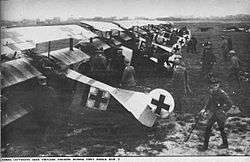Otto Esswein
Offizierstellvertreter Otto Esswein (3 March 1890 – 21 July 1918) was a German World War I flying ace credited with twelve aerial victories.[1][2]
Otto Esswein | |
|---|---|
| Born | 3 March 1890 Waiblingen, Kingdom of Württemberg, German Empire |
| Died | 21 July 1918 (aged 28) near Hartennes-et-Taux, France |
| Allegiance | German Empire |
| Service/ | Imperial German Air Service |
| Rank | Offizierstellvertreter |
| Unit | Jagdstaffel 26 |
| Awards | Military Merit Cross, Iron Cross First and Second Class, Württemberg's Military Merit Order |
Early life
Otto Esswein was born in Waiblingen, in the Kingdom of Württemberg within the German Empire, on 3 March 1890.[1]
Aviation service
Details of Esswein's entry into military service are not available. However, Esswein transferred from ground service to aviation in mid-1915. On 30 October 1917, he was assigned to Jagdstaffel 26. He scored his first victory, shooting down a Sopwith Camel on 15 November.[2] He was then slightly wounded in the right eye on 27 November.[1]

When he returned to the squadron in early 1918, a new Fokker Dr.I triplane awaited him. He used it to shoot down another Camel on 2 February, three more the next day, and two more British fighters on the 5th, one of which was the Royal Aircraft Factory SE-5 of No. 84 Squadron RFC's Lt. Cyril Ball, brother of English ace Albert Ball. By 26 March 1918, he was a double ace with ten victories. On 31 May, he increased his tally to a dozen with his two last victories.[2] He was awarded the Military Merit Cross on 3 June 1918 to join his Iron Crosses, and later awarded his home kingdom's Military Merit Order. On 16 July, in one of the pioneer usages of a parachute, he successfully bailed out of his burning plane after being shot down attacking a balloon. Five days later he was unable to repeat the feat and was killed in action in another flaming aircraft[1] over Hartennes-et-Taux, France.[2]
Sources of information
- Franks et al 1993, pp. 104-105.
- The Aerodrome website's page on Esswein http://www.theaerodrome.com/aces/germany/esswein.php Retrieved on 14 April 2010.
References
- Franks, Norman; Bailey, Frank W.; Guest, Russell (1993). Above the Lines: The Aces and Fighter Units of the German Air Service, Naval Air Service and Flanders Marine Corps, 1914–1918. Grub Street. ISBN 0-948817-73-9, ISBN 978-0-948817-73-1.